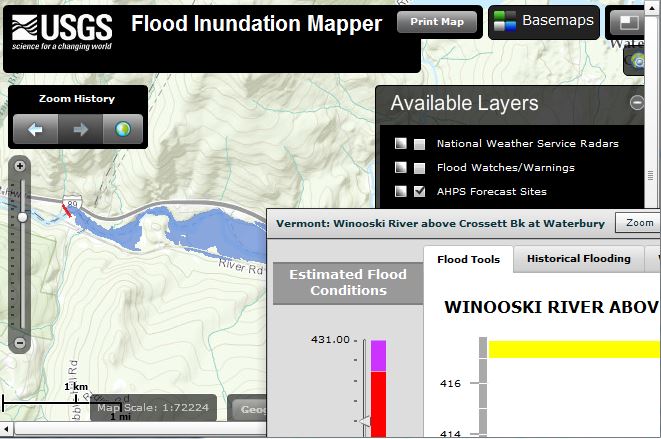Waterbury Village along the Winooski River now has an innovative on-line tool to visualize the extent of flooding. The Waterbury information is part of the Flood Inundation Mapper.
The National Weather Service (NWS) is now issuing forecasts for flow conditions on the Winooski River in Waterbury. These flow forecasts can be used to visualize the extent of overbank flooding. Users can also manually adjust the display to examine the extent of flooding.
This remarkable tool combines the daily river forecasts by the NWS with a detailed map platform prepared by the US Geological Survey (USGS).
On August 29, 2016 the National Weather Service (NWS) began issuing forecasts for the Winooski River at Waterbury Vermont. Predictions of water levels extending out three days will be updated once daily during normal and low flow conditions, and more frequently as conditions warrant during high water or flooding. These new forecasts are possible based on work by the US Geological Survey (USGS) in cooperation with the Vermont Agency of Natural Resources.
"We are pleased to begin river forecasts for the Winooski at Waterbury" said Andy Nash, Meteorologist in Charge at the National Weather Service in Burlington. "River forecasts will increase our capability to warn of impeding floods and provide sound information for local emergency managers and responders to make critical decisions". Mr. Nash went on to note that river forecasts will be useful during quiet periods: "Recreationists such as paddlers and anglers will benefit from daily river level forecasts, as well as other interests such as dam operators and power companies".
River forecasts were developed at the NWS Northeast River Forecast Center (NERFC) in Taunton MA, a regional center of expertise in water forecasts. Hydrologists at the NERFC utilized flood studies done by the USGS in 2015 that created flood inundation maps for Waterbury. These river simulations were adapted and improved so that daily forecasts of river flows are predicted as part of the Winooski River system. The result is the forecast for Waterbury that is integrated with existing forecasts for the Winooski River at Montpelier and Essex Junction VT. Forecasts will continue to originate with the NERFC, and be disseminated by the NWS Office in Burlington, Vermont.
Forecast information for the Winooski River at Waterbury and other locations are available at the website www.weather.gov/btv by clicking on the "Rivers and Lakes" link. A graphic and text display shows past observed river levels and future forecasts, including in times of flood how long it will take the river to reach flood stage, how high the river will rise, and how long the flood will last. In 2016 the USGS also enhanced the continuous monitoring of river flows at Waterbury.
Flood stage for the Winooski at Waterbury is set at 419 feet, when the river spills its banks into low lying fields near Waterbury Village and downstream to Richmond. Moderate flooding begins near 421 feet, when Rowe Field in Waterbury floods and water approaches lower parking lots in the Waterbury State Office Complex. An elevation of 428 feet is considered major flooding, when water floods homes and businesses in Waterbury Village, and is equivalent to the Federal Emergency Management Agency’s (FEMA) 1 Percent Annual Chance Flood.
The community was hit hard by Tropical Cyclone Irene on August 28 and 29 2011, when the river rose to nearly 430 feet. The flood studies by the USGS were a direct result of FEMA support following the flooding from Irene in 2011.
The USGS flood study final report can be found at the following web site: http://pubs.usgs.gov/sir/2015/5077/
The flood inundation maps are located at: http://wimcloud.usgs.gov/apps/FIM/FloodInundationMapper.html#
NOAA’s National Weather Service is the primary source of weather data, forecasts and warnings for the United States and its territories. The National Weather Service operates the most advanced weather and flood warning and forecast system in the world, helping to protect lives and property and enhance the national economy.
The USGS investigates the occurrence, quantity, quality, distribution, and movement of surface and underground waters and disseminates the data to the public, State and local governments, public and private utilities, and other Federal agencies involved with managing our water resources.




